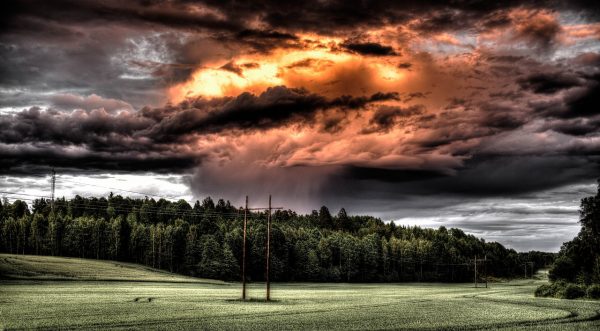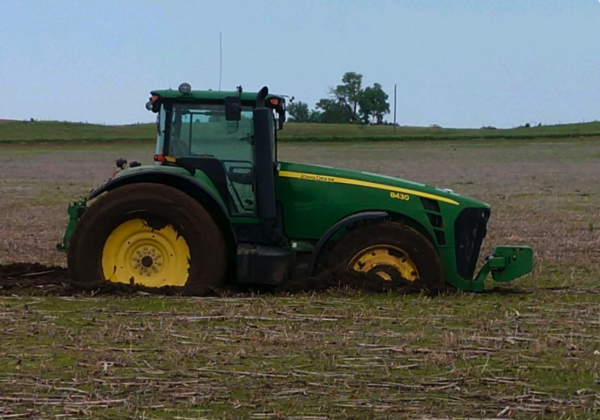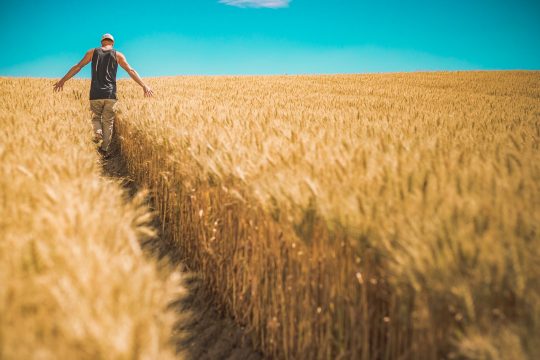Home » Posts tagged 'food' (Page 6)
Tag Archives: food
Where to Get Seeds When Online Sources are SOLD OUT
Where to Get Seeds When Online Sources are SOLD OUT
With the current shift in the economy, and with supply lines being interrupted all around the nation, there has been a massive – massive! – spike in the number of people interested in growing a garden this spring.
Hundreds of thousands – possibly millions – of new gardens are springing up across the country. Some are large, some are small, and all are important. Some people are calling them Victory Gardens, others are calling them crisis gardens. Even those living in high-rise apartments are planting “Victory Sills,” pots or glasses of water on their windowsills in which herbs or sprouting vegetables are rooting. Whatever the name, cumulatively, they’ll be an important source of fresh produce.
Normally the renaissance in gardening of all sorts would be nothing but good news. However, the surge of interest from both novice and experienced gardeners is stretching seed companies to the limit. Many companies have stopped answering the phones and are putting up online pleas for understanding as they try to handle backorders with limited capacity and inventory.
Here are some other places to get seeds.
If you find yourself unable to order seeds online, here are some alternate sources to consider:
- If you’ve planted non-hybrid seeds in previous years and have saved your seeds for planting this year, congratulations (and be generous with your gardening friends). This is the ultimate way to obtain seeds – by saving your own. Ultimately this is the position in which everyone should be. (Learn more about saving seeds here.)
- Ask your gardening friends for any surplus seeds they can spare. They may also be able to offer helpful planting advice.
…click on the above link to read the rest of the article…
The Fuel Shortage in Venezuela Will Lead to Starvation
The Fuel Shortage in Venezuela Will Lead to Starvation
Dear readers, those who already know me are aware I used to write about confirmed facts we all care about as preppers. At this point in my life I hardly can be considered a prepper, though. A survivor? Sure. I’ve been in much better conditions (as I have mentioned earlier in previous articles) than other migrants. Always had a roof and something to eat, and could buy my kiddo a good meal every now and then and even an ice cream, cookies and the occasional chocolate when he asked for it. Maybe I have not eaten a grilled steak every two days, but I haven’t starved. Have I seen myself rationing? Sure. At least I have something to ration. I know I have been a little…disperse. I have realized that facing with a reality you had only had imagined in your worst scenario fantasies, is harder than I thought. That´s why I´ve been trying to recover myself, and getting used to the quite grim possibility of death far away from my homeland.
This said, I received a few audios about a situation that is presenting given the scarcity of gasoline that has already impacted the food supply. The person sending me these materials is reliable, and informed me that indeed that happened.
There’s a fuel shortage in Venezuela
The local majors, governors, and uniforms have confiscated the fuel, and they sell them in dollars, for their own personal profit. This way they are bypassing tax controls, impeding the audit, and pocketing all the money they collect. They are trafficking with the fuel, and this brings along two consequences.
…click on the above link to read the rest of the article…
Ignoring US Alarms, Alberta Meat Packers Spawned Canada’s Biggest Outbreak
Ignoring US Alarms, Alberta Meat Packers Spawned Canada’s Biggest Outbreak
As the virus gripped US plants, the union pleaded for a shutdown. They were rebuffed.
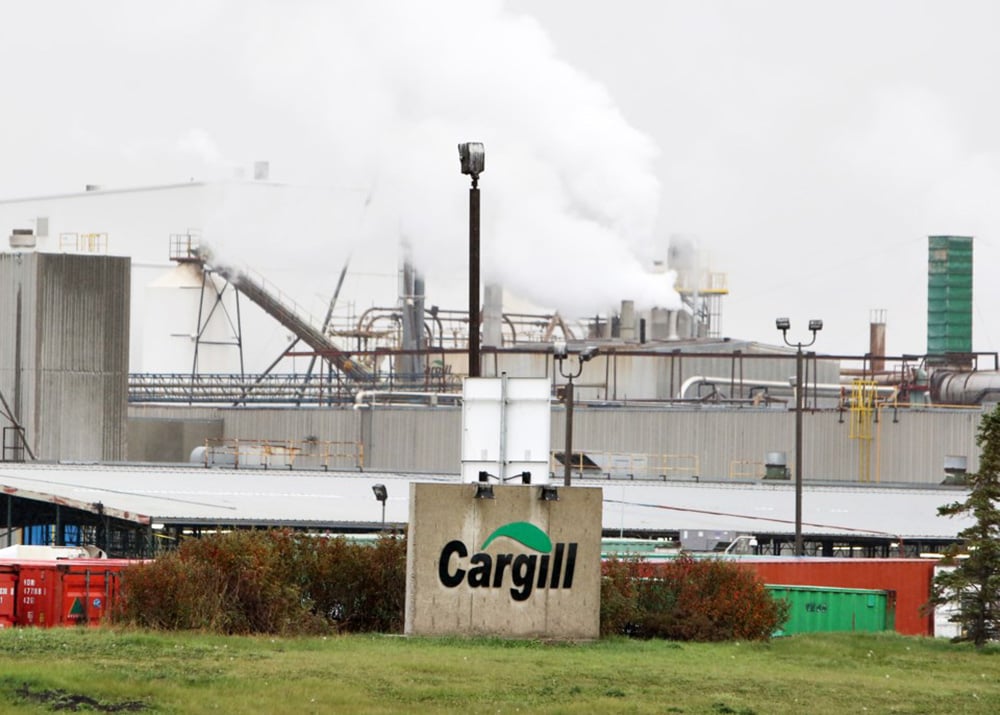
Canada’s largest outbreak of COVID-19 swept through two meat-packing plants in southern Alberta two weeks after the provincial government ignored union requests to temporarily close both of the plants.
And it mirrored a series of recent, well-documented hot-zone eruptions in meat plants in the United States.
More than 600 immigrant workers and community members have been infected while the disease has killed at least three people at Cargill’s High River plant and the JBS food plant in Brooks, Alta.
“The real issue here is a moral issue,” charged Thomas Hesse, president of the United Food and Commercial Workers Local 401, which represents workers at the plants. “How do we as a society want to bring food to our tables?”
Rachel Notley, the former premier of Alberta, has called for a full public inquiry.The Tyee is supported by readers like you Join us and grow independent media in Canada
“It is unconscionable that we now have a situation where hundreds of people have contracted a deadly virus,” said Notley, who leads the NDP Official Opposition. “What kind of concerns put the lives of workers so low?” she asked on CBC Radio yesterday.
Alberta’s growing outbreaks follow in the wake of deadly events in the U.S. where meat-packing plants have become COVID-19 incubators.
The U.S. recorded its largest single cluster of cases at a pork-processing facility in Sioux Falls, South Dakota in early April. By the time the Chinese-owned facility closed for two weeks there were nearly 900 cases.
…click on the above link to read the rest of the article…
Eight Meatpacking Plants Close In Weeks Across America Stoking Food Shortage Fears
Eight Meatpacking Plants Close In Weeks Across America Stoking Food Shortage Fears
Update (April 23): Food shortages across the country are coming a lot quicker than anyone has anticipated. A total of eight meatpacking plants have already gone offline in weeks. On Thursday morning, we noted how pork shortages could hit households by the first week of May.
Now we’re starting to learn the dominos are falling, with meatpacking plants shuttering operations across the country because of the coronavirus outbreak.
Tyson Foods Inc. has announced the third plant closure in about a week and the second closure within 24 hours. The latest announcement crossed the wires on Thursday afternoon, specifies how a major beef facility in Pasco, Washington, is shutting down operations because of the virus outbreak, reported Bloomberg.
“We’re working with local health officials to bring the plant back to full operation as soon as we believe it to be safe,” Steve Stouffer, head of Tyson Fresh Meats, said in the company’s statement.
“Unfortunately, the closure will mean reduced food supplies and presents problems to farmers who have no place to take their livestock. It’s a complicated situation across the supply chain.”
In total, eight major meatpacking plants have closed in the last several weeks. We noted on Thursday morning that a “rash of coronavirus outbreaks at dozens of meatpacking plants across the nation is far more extensive than previously thought.”
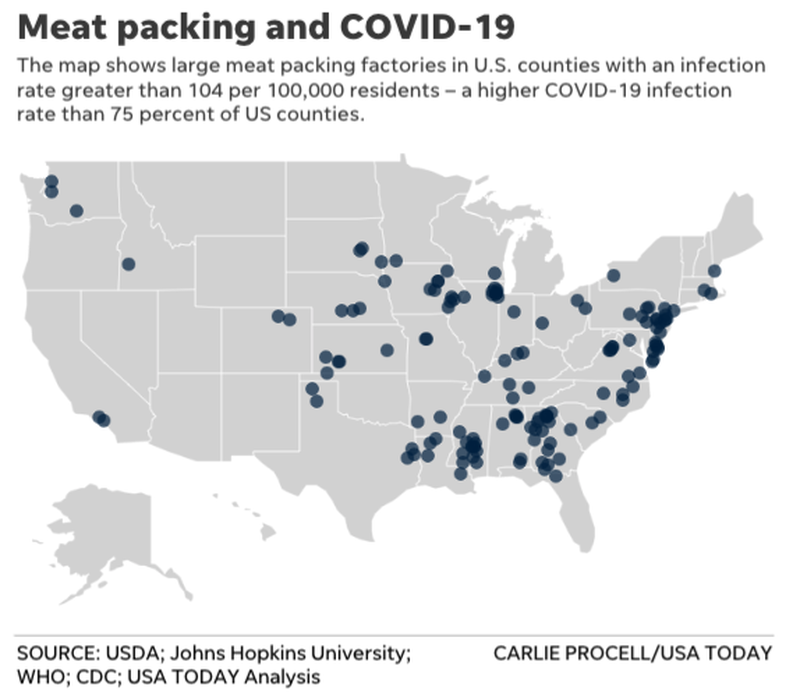
As for the plant in Washington, well, it produces enough beef to feed four million people per day. Just imagine what happens when people who have just lost their jobs experience food shortages, or maybe rapid food inflation. It could be a trigger for social unrest.
* * *
Update (19:50): It appears meatpacking facilities in America’s heartland could be the next epicenter of the coronavirus outbreak.
On Wednesday, Tyson Foods announced two closures of meatpacking facilities because of coronavirus related issues.
Here’s the timeline of closures:
…click on the above link to read the rest of the article…
4 Things I Learned by NOT Going to the Grocery Store for a Month
4 Things I Learned by NOT Going to the Grocery Store for a Month
I just walked into my grocery store for the first time in a month, and it was surreal. First, because I was there without my two kids (ages 5 and 7), so I kept feeling like I was forgetting the most important thing. What is it? Oh yes, the most important thing is shouting:
“Do NOT climb in the freezer bin!” at exactly the right moment.
Not too soon, or they forget that you said it and climb in. Not too late, or you’re explaining muddy footprints on the frozen turkeys to disgruntled grocery employees.
Just kidding, my kids have never climbed in the freezer bin. They’ve gotten a leg up, but I always shout at the right moment. By the time we get to produce, though, I’m frazzled from the rapid oscillation of my eyeballs from list to shelf to list, and I’m not quite as on-the-ball. They have climbed in that giant box of pumpkins.
In addition to the lack of shouting, at my grocery store this week there was a cordon so people could line up to get in. There was a new “maximum occupancy 537 persons” sign on the door. There were empty spaces on some shelves, and a lot less friendliness. Other than that, it was the same old fluorescent-lit cavern I despise.
Before I get to what not going to the store taught me, I should explain why I haven’t been to the store since before my state’s stay-at-home order was issued.
1. I hate shopping, so if there’s any little excuse for not going (such as contagion or it’s a Sunday), I am so not there.
…click on the above link to read the rest of the article…
10 Grocery Items That Disappeared Almost Immediately When an Emergency Was Declared
10 Grocery Items That Disappeared Almost Immediately When an Emergency Was Declared
Planning and preparing an emergency food pantry now will help you keep popular food items stocked and ready for the next crisis.

Large-scale events can quickly cause significant economic, social, and political disruption in its wake. Studies have shown most households are not prepared for a two-week disruption, let alone a month-long ordeal such as what we are enduring with COVID-19. As a result, the public quickly sees how vulnerable they are to an emergency. An unprecedented strain has been put on our food system as a result of the initial food grab at the beginning of the health crisis.
With grocery items flying off the shelves and a huge demand on food banks, its no wonder that vegetable and garden seeds have been in high demand because of interest in sustainable food production. We now see that when a large population is hit with a rapid, far from equilibrium event, the system itself cannot keep up with the demand. The result, at best, shows how thin the protections of society are when this type of event happens and we must learn from this.
In the wake of the COVID-19 food panic, certain food staples disappeared almost immediately; almost all of which are listed in our 25 must-have survival foods. While toilet paper seems to be the one item that is ingrained in our memories as the grocery item that initially incited the run on the grocery stores, the items listed below have been in short supply if not out of stock for weeks on end.
10 Food Items That Disappeared Almost Immediately in the COVID-19 Health Crisis
- Pasta and tomato sauce
- Yeast
- Flour
- Sugar
- Milk
- Eggs
- Butter
- Rice
- Beans
- Peanut butter
…click on the above link to read the rest of the article…
The Next Crisis: Food
The Next Crisis: Food
There’s a reason we’ve been urging folks to plant a garden
“Oh crap! Bermuda grass? In my garden space? The kind with underground runners that’s nearly impossible to eliminate except by digging up every single root and rhizome?”
For reasons I cannot fully explain I became absolutely inspired to “find a place” starting last September.
Today, my partner Evie and I are settling in to our new home. We closed on it on January 28th and it took a solid month to move things over from our former residence.
First things first, we set about correcting a decade’s worth of deferred maintenance. The furnace relay switch was quite dodgy, the gravel on the driveway was way past due for replenishment, the gutters leaked, and the apple trees were in desperate need of pruning.
Now that it’s April, I find myself every day — after my research and writing is done of course — out in the old garden space, digging new beds and turning over every square inch of the soil. Not because I want to, but because some misguided former owner thought planting Bermuda grass in the garden was a good idea.
This is the sort of grass that spreads to new horizons with meaty underground rhizomes that can spread ridiculously far from the parent plant. Arggh!
Oh, and the new chicken house, predator-proofed with hardware cloth on every possible entry point, had to be set up, too.
The list of needed improvements seem to stretch as far as the eye can see. An insurmountable pile of tasks that will be required to raise it to our high standards of creating a place of lasting beauty and abundance.
Right now? It’s a barely-dented tapestry of a thousand projects. You might be unimpressed if you took stock of all that we haven’t tackled yet.
…click on the above link to read the rest of the article…
Panicked Hong Kongers Hoard Food, Water, Supplies Amid Coronavirus Hysteria
Panicked Hong Kongers Hoard Food, Water, Supplies Amid Coronavirus Hysteria
Now that striking health-care workers have successfully forced Carrie Lam’s government to close most of its border links with the mainland and dramatically restrict travel from elsewhere in China, a full-on panic has engulfed the city, fueled by “malicious rumors” about supply shortages, Reuters reports.
Chaos has erupted in some areas as supermarkets have imposed limits on how many items customers can buy. Hundreds of shoppers have thronged aisles of supermarkets as they struggle to buy up as many consumer staples – rice, water, meat, noodles etc. – as they can again on Friday. Chinese-ruled Hong Kong has reported 25 cases of the virus and one of only three deaths outside the mainland.
“Everyone’s snatching whatever they can get. I don’t even know what’s going on,” said a 72-year-old woman surnamed Li as she clutched two bags of toilet rolls.
The situation in Hong Kong right now is incredibly tense. Many still have horrible memories from the SARS outbreak of 2002-2003, which killed roughly 300 people as it swept through the city. But the scare also comes after months of anti-Beijing protests by the Hong Kong pro-democracy movement.
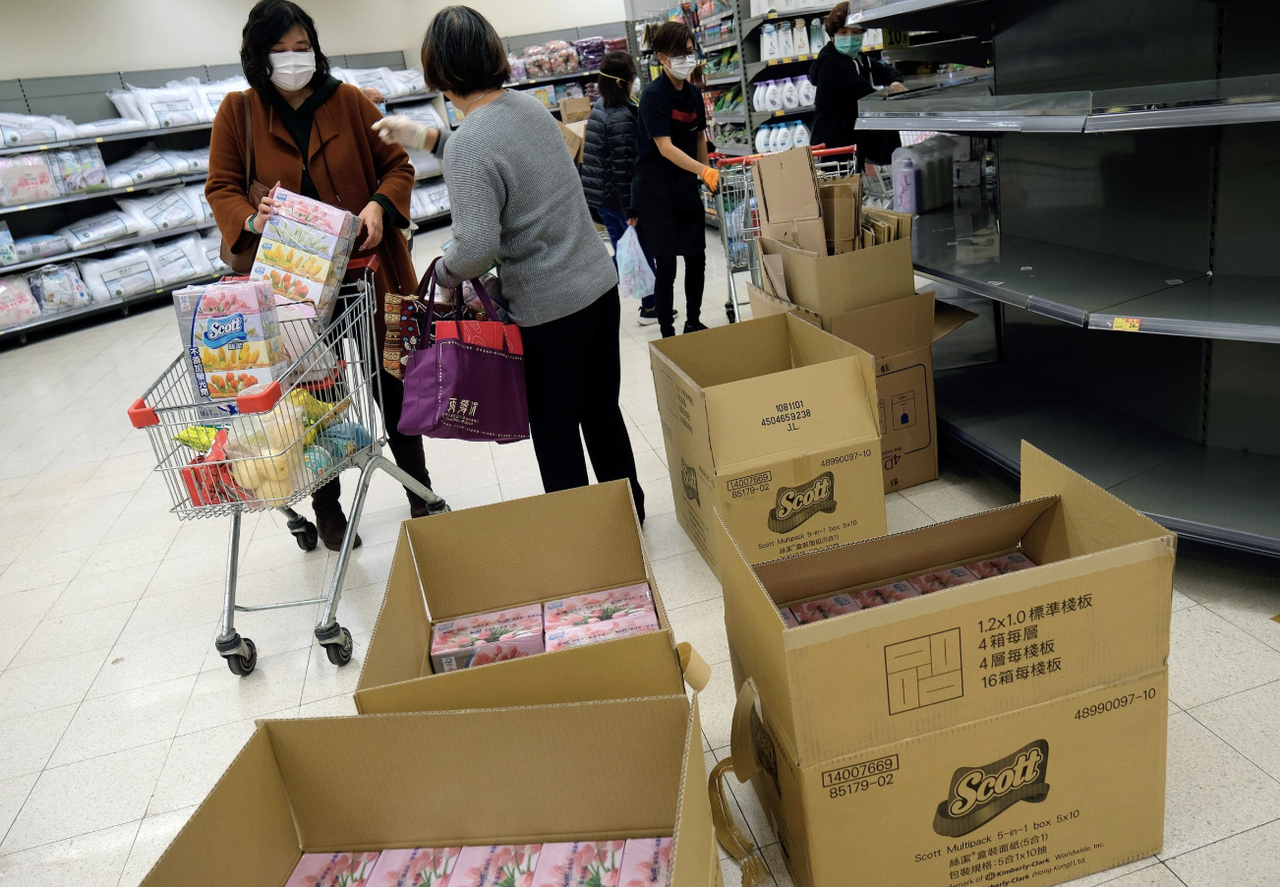
Already, Matthew Cheung, chief secretary for administration, said that Hong Kong people returning from the mainland must stay home for a fortnight or risk a $3,200 fine and up to 6 months in jail. Non-Hong Kong residents must stay in government isolation centers or hotel rooms for the same period, facing the same penalties.
“Self discipline and having everybody in Hong Kong fighting…this infectious disease is the most important thing,” said Sophia Chan, the city’s health secretary.
There was some good news in Hong Kong: Thousands of medical workers who had been on strike this week to press the government to close the border voted to suspend their action on Friday night, though they said they would continue to pressure the government for tighter measures to suppress the outbreak.
…click on the above link to read the rest of the article…
Food Is Freedom: How Washington’s Food Subsidies Have Helped Make Americans Fat and Sick
Food Is Freedom: How Washington’s Food Subsidies Have Helped Make Americans Fat and Sick

Farm subsidies are perhaps the ultimate, but secret, third rail of American politics. While entitlements are discussed out in the open, farm subsidies are rarely talked about – even though they are the most expensive subsidy Washington doles out.
All told, the U.S. government spends $20 billion annually on farm subsidies, with approximately 39 percent of all farms receiving some sort of subsidy. For comparison, the oil industry gets about $4.6 billion annually and annual housing subsidies total another $15 billion. A significant portion of this $20 billion goes not to your local family farm, but to Big Aggie.
(Note that this $20 billion annual farm subsidy figure doesn’t take into account the 30+ years of ethanol subsidies to the corn industry nor export subsidies to U.S. farmers issued by the USDA.)
The government never properly explains why this is. Certainly small farmers are growing their crops at enormous risk. However, it’s not clear that agriculture is any different than other high-risk industries – especially because the United States is blessed with some of the most fertile farmland in the world, and a highly skilled labor force.
Subsidies don’t just cost taxpayers, an expense that might properly be justified by showing a return on investment. Subsidies also provide powerful disincentives against innovation, as well as cost effectiveness and diversification of land use.
There is also a strong case to be made that farm subsidies are a major driver of the obesity and cancer epidemic in the United States. Every time Washington interferes in the private sector, they are picking winners and losers. The winners chosen are companies producing food that’s high in calories and low in nutritional density – and that helps make Americans sick and fat, because it distorts what food is available at what price.
…click on the above link to read the rest of the article…
Climate crisis needs radical food changes
Climate crisis needs radical food changes
The entire food system needs to change, researchers say.
From farm to fork, agriculture fuels global heating. Can the world eat well, but stay a little cooler? That will need radical food changes.
LONDON, 3 July, 2019 – To feed 9 billion people by 2050, and keep planet Earth from overheating, will mean massive and radical food changes – and not just in the way food is grown.
To contain global temperatures to no more than 2°C above the average for most of human history will require humanity to change its diet, contain its appetite and reform the entire system of food production and distribution.
This is the verdict of the latest study of the challenge set in Paris in 2015, when 195 nations promised to limit global warming – driven by profligate use of fossil fuels and by the conversion of forest, grassland and wetlands into commercial use – to “well below” 2°C by 2100.
Researchers report in the journal Sustainability that they looked at 160 studies and analyses of global agriculture and food systems and most closely at the world’s smallholders and markets that sustain as many as 2.5 billion people, mostly in the developing world.
Farming’s massive impact
Small farmers account for about a third of global agriculture’s greenhouse gas emissions, but these include also many of the people most vulnerable to the coming climate crisis, which is likely to put harvests at hazard on a global scale.
Agriculture, together with forestry and changes in land use, accounts for a quarter of all the carbon dioxide, methane and oxides of nitrogen that fuel global warming.
Just on its own, the action of growing grain, fruit and vegetables or feeding grazing animals accounts for no more than 12% of global warming, but a third of all the food that leaves the farm gate is wasted before it arrives on the supper table.
…click on the above link to read the rest of the article…
Fake Food, Fake Meat: Big Food’s Desperate Attempt to Further the Industrialisation of Food
Fake Food, Fake Meat: Big Food’s Desperate Attempt to Further the Industrialisation of Food

Photograph Source: Mattes – CC BY-SA
The ontology and ecology of food
Food is not a commodity, it is not “stuff” put together mechanically and artificially in labs and factories. Food is life. Food holds the contributions of all beings that make the food web, and it holds the potential of maintaining and regenerating the web of life. Food also holds the potential for health and disease, depending on how it was grown and processed. Food is therefore the living currency of the web of life.
As an ancient Upanishad reminds us “Everything is food, everything is something else’s food. “
Good Food and Real Food are the basis of health .
Bad food, industrial food, fake food is the basis of disease.
Hippocrates said “Let food be thy medicine”. In Ayurveda, India’s ancient science of life, food is called “sarvausadha” the medicine that cures all disease.
Industrial food systems have reduced food to a commodity, to “stuff” that can then be constituted in the lab. In the process both the planet’s health and our health has been nearly destroyed.
75% of the planetary destruction of soil, water, biodiversity, and 50% of greenhouse gas emissions come from industrial agriculture, which also contributes to 75% of food related chronic diseases. It contributes 50% of the GHG’s driving Climate Change. Chemical agriculture does not return organic matter and fertility to the soil. Instead it is contributing to desertification and land degradation. It also demands more water since it destroys the soil’s natural water-holding capacity. Industrial food systems have destroyed the biodiversity of the planet both through the spread of monocultures, and through the use of toxics and poisons which are killing bees, butterflies, insects, birds, leading to the sixth mass extinction.
…click on the above link to read the rest of the article…
U.S. Farms Are Facing Their Worst Crisis In A Generation – And Now Here Comes Another Monster Storm
U.S. Farms Are Facing Their Worst Crisis In A Generation – And Now Here Comes Another Monster Storm
The combination of the wettest planting season in U.S. history, a catastrophic trade war with China and economic conditions that are brutal for small farms has produced a “perfect storm” for U.S. farmers. Farm bankruptcies have already risen to the highest level in 7 years, but many expect that they will soon surge to all-time record highs. Due to the incredibly wet weather, millions upon millions of acres of prime U.S. farmland will not be planted with crops at all this year. And millions of acres that do get planted will yield a lot less than usual because of the wretched conditions. Meanwhile, the U.S. will export far less corn and soybeans than usual this year due to our trade conflicts with China and Mexico. With much less international demand, U.S. farmers are going to have an increasingly difficult time trying to make a profit on anything they are able to grow. In the end, thousands of farmers will not be able to recover from this crisis and will be forced out of the industry for good.
According to USA Today, “a near biblical parade of misfortune” has created “the worst farm crisis since the 1980s”…
American farmers already plagued by a near biblical parade of misfortune that includes years of low prices and a trade war with China are now grappling with record Midwest rain that will likely prevent a large portion of this year’s crop from even getting planted.
The troubles have created the worst farm crisis since the 1980s, when oversupplies and a U.S. grain embargo against the Soviet Union forced thousands of farmers into bankruptcy, experts say.
So we can definitely say that this is the worst farm crisis in a generation, but the truth is that this crisis is far from over.
…click on the above link to read the rest of the article…
Do We Face a Global Food Disaster?
Do We Face a Global Food Disaster?
No, this is not at all an endorsement of the apocalyptic scenarios of AOC or that famous young Swedish climate expert, Greta. It is, however, a look at unusual weather disasters in several key growing regions from the USA to Australia, the Philippines and beyond that could dramatically affect food availability and prices in the coming year. That in turn could have major political implications depending on how the rest of the growing season develops.
USA Midwest Waterlogged
According to the latest May 20 report of the National Agricultural Statistics Service (NASS) of the US Department of Agriculture, corn and soybean crops are well behind the planting growth levels normal this time of the planting season. They report that only 49% of all planned corn acreage in the US has been planted compared with 78% at this time a year ago. Of that only 19% has yet emerged from the ground compared to 47% in May 2018. In terms of soybeans, barely 19% of crops have yet been planted compared with 53% a year before. Rice acreage planted is down to 73% compared to 92% a year ago in the six US rice-growing states. Of course, should weather dramatically improve the final harvest numbers could improve. It is simply too early to predict.
The USA is by a wide margin the world largest soybean producer with 34 percent of the world’s soybean production and 42% of world exports prior to the China trade battles. The US is also the world largest corn or maize producer, almost double China, the number two. A serious harvest failure in these two crops could significantly affect world food prices, leaving aside the unfortunate fact that almost all US soybeans and corn are GMO crops. They are mainly used in animal feed.
Due To Cataclysmic Flooding, Millions Upon Millions Of Acres Of U.S. Farmland Will Not Be Planted With Crops This Year
Due To Cataclysmic Flooding, Millions Upon Millions Of Acres Of U.S. Farmland Will Not Be Planted With Crops This Year
It looks like 2019 could be the worst year for U.S. agriculture in modern American history by a very wide margin. As you will see below, millions upon millions of acres of U.S. farmland will go unused this year due to cataclysmic flooding. And many of the farmers that did manage to plant crops are reporting extremely disappointing results. The 12 month period that concluded at the end of April was the wettest 12 month period in U.S. history, and more storms just kept on coming throughout the month of May. And now forecasters are warning of another series of storms this week, and following that it looks like a tropical storm will pummel the region. As Bloomberg has pointed out, we have truly never seen a year like this ever before…
There has never been a spring planting season like this one. Rivers topped their banks. Levees were breached. Fields filled with water and mud. And it kept raining.
Many farmers just kept waiting for the flooding and the rain to end so that they could plant their crops, but that didn’t happen.
At this point it is too late for many farmers to plant crops at all, and it is now being projected that 6 million acres of farmland that is usually used for corn will go completely unsown this year…
There has never been weather like this, either. The 12 months that ended with April were the wettest ever for the contiguous U.S. That spurred other firsts: Corn plantings are further behind schedule for this time of year than they have been in records dating to 1980 and analysts are predicting an unheard-of 6 million acres intended for the grain may simply go unsown this year.
…click on the above link to read the rest of the article…
American Soil Is Being Globalized: Nearly 30 Million Acres Of U.S. Farmland Is Now Owned By Foreigners
American Soil Is Being Globalized: Nearly 30 Million Acres Of U.S. Farmland Is Now Owned By Foreigners
All across America, U.S. farmland is being gobbled up by foreign interests. So when we refer to “the heartland of America”, the truth is that vast stretches of that “heartland” is now owned by foreigners, and most Americans have no idea that this is happening. These days, a lot of people are warning about the “globalization” of the world economy, but in reality our own soil is rapidly being “globalized”. When farms are locally owned, the revenue that those farms take in tends to stay in local communities. But with foreign-owned farms there is no guarantee that will happen. And while there is plenty of food to go around this is not a major concern, but what happens when a food crisis erupts and these foreign-owned farms just keep sending their produce out of the country? There are some very serious national security concerns here, and they really aren’t being addressed. Instead, the amount of farmland owned by foreigners just continues to increase with each passing year.
Prior to seeing the headline to this article, how much U.S. farmland would you have guessed that foreigners now own?
Personally, I had no idea that foreigners now own nearly 30 million acres. The following comes from NPR…
American soil.
Those are two words that are commonly used to stir up patriotic feelings. They are also words that can’t be be taken for granted, because today nearly 30 million acres of U.S. farmland are held by foreign investors. That number has doubled in the past two decades, which is raising alarm bells in farming communities.
How did we allow this to happen?
And actually laws regarding land ownership vary greatly from state to state. Some states have placed strict restrictions on foreign land ownership, while in other states it is “a free-for-all”…
…click on the above link to read the rest of the article…


